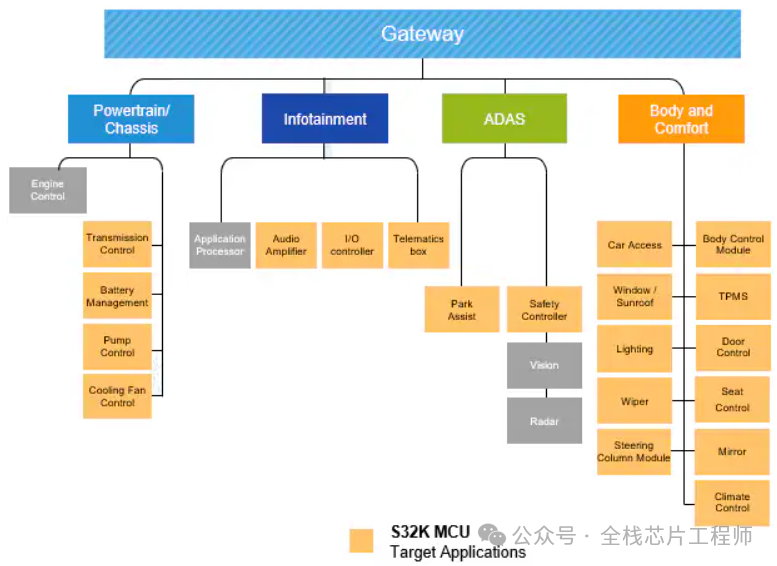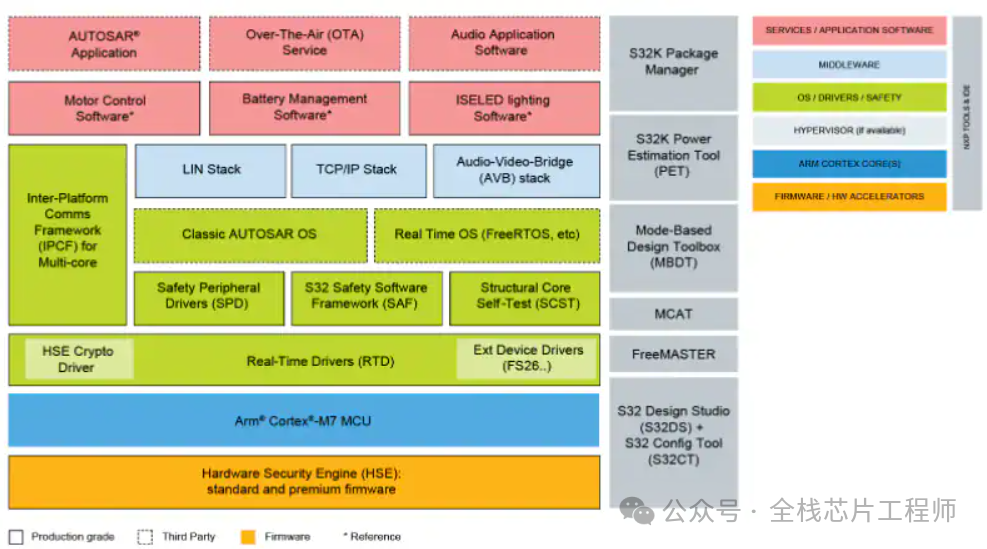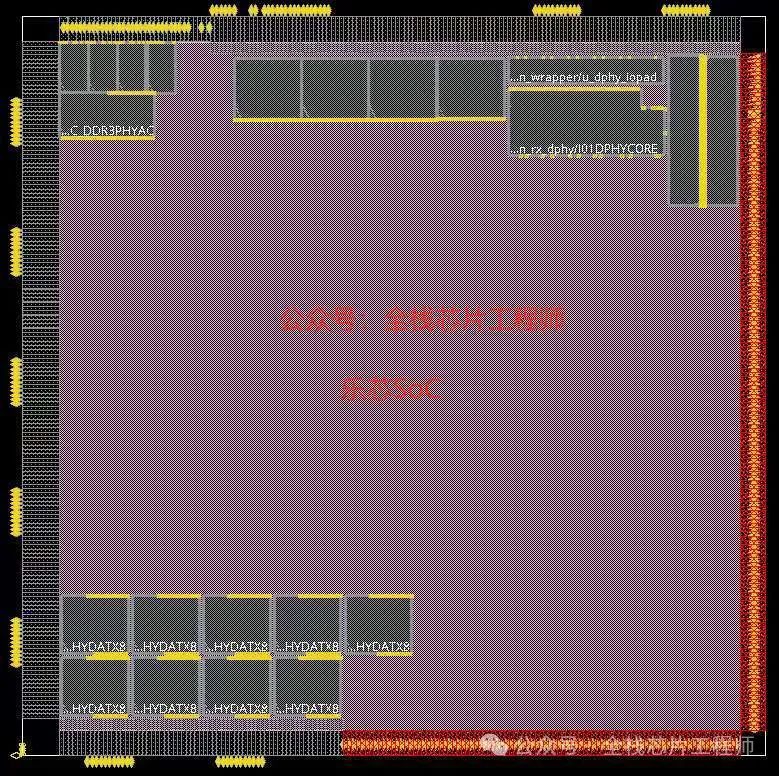The NXP S32K3 series MCU is a general-purpose microcontroller designed specifically for the evolution of automotive electronic and electrical architecture (E/E Architecture), demonstrating significant advantages in applications such as Domain Controllers and Zonal Controllers. Let’s follow along with Jingxin to explore its hardware features, functional safety, software support, and practical application scenarios:

Where is the S32K3 used? Let’s outline the application scenarios:
-
Body and Comfort Systems used for door control, seat adjustment, and lighting management, achieving centralized control through multitasking capabilities, thereby reducing the number of ECUs.
-
Battery Management System (BMS) supports high-precision ADC (12-bit 1Msps) and CAN FD communication, monitoring battery status in real-time and optimizing charge/discharge strategies to enhance range.
-
Zonal Controller integrates body electronics, power distribution, and network gateway functions, enabling cross-domain communication via Ethernet TSN, supporting Software Defined Vehicle (SDV) architecture.
-
Powertrain and Chassis Control lockstep core configuration ensures the reliability of motor control and safety braking systems, meeting ASIL D requirements.
Next, let’s take a look at the S32K3 chip architecture:
-
Multicore Architecture and Scalability The S32K3 is based on the Arm Cortex-M7 core, supporting single-core, dual-core, triple-core, and lockstep configurations, with a maximum clock frequency of 240MHz, and integrates a Floating Point Unit (FPU). Its flash memory capacity ranges from 512KB to 8MB (supporting ECC verification), meeting the computational needs of different domain controllers.
-
Lockstep Core Design: Achieves ASIL D functional safety through dual-core redundancy operation and real-time result comparison, suitable for high safety requirements in powertrain or chassis control.
Efficient Communication Interfaces supports various in-vehicle communication protocols, including Ethernet TSN/AVB (100Mbps/1Gbps), CAN FD, FlexIO (supporting SPI/I²C/IIS, etc.), and QSPI interfaces, meeting the high bandwidth and low latency communication needs of domain controllers.
Integrated Peripherals and Low Power Design
-
Motor Control Optimization: Built-in 16-bit eMIOS timers and Logic Control Units (LCU) can generate complementary PWM signals and insert dead time, suitable for motor drive scenarios.
-
Low Power Modes: Supports Run and Standby modes, reducing energy consumption through clock gating and power gating technologies, with fast wake-up features ensuring real-time response.
Next, we must discuss functional safety:
-
Compliance with ISO 26262 Standards The S32K3 achieves ASIL B/D safety levels through hardware and software co-design, integrating Fault Collection and Control Units (FCCU), hardware watchdogs, and clock/power monitoring modules to detect and respond to system anomalies, ensuring the safety of critical functions.
-
Hardware Security Engine (HSE) The HSE module supports encryption algorithms such as AES-256, ECC, and RSA, providing secure boot, key storage, and firmware signature verification functions to prevent unauthorized firmware tampering. Additionally, the HSE complies with ISO 21434 information security standards, suitable for V2X scenarios.
-
Secure Boot and FOTA Support supports zero downtime A/B partition firmware updates (FOTA), combined with an automatic address translation mechanism, ensuring the reliability and rollback capability of wireless upgrades, meeting the continuous iteration needs of domain controllers.
We cannot overlook the software ecosystem:
-
Real-Time Drivers (RTD) and AUTOSAR Compatibility NXP provides a free RTD software package compliant with ISO 26262 standards, supporting both AUTOSAR and non-AUTOSAR architectures, simplifying low-level driver development. For example, by integrating Eclipse and GCC toolchains through S32 Design Studio, development efficiency is enhanced.
-
Safety Software Framework and Toolchain
-
SAF (Safety Software Framework) and SCST (Structural Core Self-Test): Pre-integrated safety libraries, supporting Memory Built-In Self-Test (MBIST) and Logic Built-In Self-Test (LBIST), shortening the functional safety certification cycle.
-
Third-Party Tool Support: Such as IAR Embedded Workbench certified by TÜV SÜD, providing code optimization, debugging, and safety analysis functions, suitable for complex domain controller development.
Digital Twin and Model Development Combined with the MCSPTR2AK396 development kit, the S32K3 can build digital twin models for real-time simulation and parameter optimization of motor control algorithms. For example, in new energy vehicle traction motors, model predictive control (MPC) improves efficiency by 2.1% and reduces temperature rise by 9°C.
 The NXP S32K3, with its high-performance multicore architecture, high safety design, and comprehensive software ecosystem, has become a core solution for domain controller development, covering applications from traditional body control to emerging zonal controllers, facilitating the evolution of automotive electronic and electrical architecture towards centralization and intelligence.
The NXP S32K3, with its high-performance multicore architecture, high safety design, and comprehensive software ecosystem, has become a core solution for domain controller development, covering applications from traditional body control to emerging zonal controllers, facilitating the evolution of automotive electronic and electrical architecture towards centralization and intelligence.
Jingxin SoC Training Camp One-on-One Lifetime Guidance
Jingxin SoC [Design] Practical Course
Jingxin SoC [Verification] Practical Course
Jingxin SoC [DFT] Practical Course
Jingxin SoC [Backend] Practical Course
[Exciting] Full Process Practical Course for Chips
2.5GHz High-Performance Digital Backend Practical Course (12nm Project 1)
Heart and Soul—12nm Automotive DFT+APR Practical Course Directory! (12nm Project 2)
